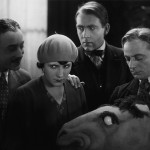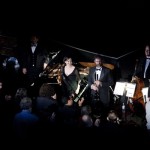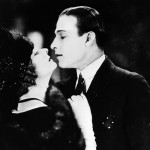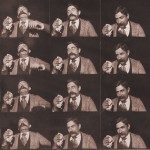The San Francisco Silent Film Festival
Nothing to Keep Quiet About...
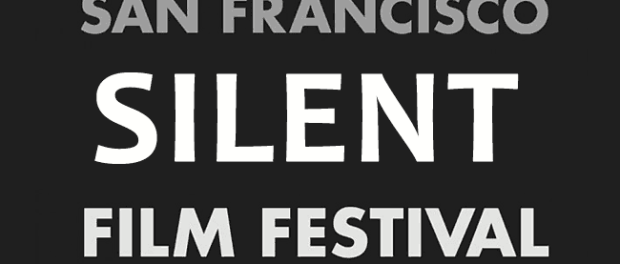
By Ron Merk
Each year the staff of the San Francisco Silent Film Festival programs a weekend of truly amazing films and discoveries from the golden age of silent films. With some of the finest live-music accompaniment, audiences delight to the power and brilliance of the imagery created by silent film makers, and experience these films the way they were meant to be presented. The Castro Theater, itself built during the silent film era, serves as the perfect place to watch these nearly century-old films on the big screen again.
If you’ve never attended this festival, you’ve missed a truly unique experience, and if you’ve attended the festival in the past, I need not say another word. Silence (or should I say “silents”) is golden.
Here’s is some important information about the festival programming and ticket purchase:
The 19th San Francisco Silent Film Festival
May 29–June 1, 2014
Castro Theatre, San Francisco
silentfilm.org
True art transcends time.
SAN FRANCISCO – Live cinema takes the spotlight at the 19th San Francisco Silent Festival from May 29th through June 1st at the Castro Theatre. For information, please visit www.silentfilm.org.
From iconic silent film actors to fantastic restorations, the lineup for this year spans the globe to bring an outstanding mix of classic film from this golden age of movies – all accompanied by live music. Here are some highlights from this year’s stellar lineup:
OPENING NIGHT: THE FOUR HORSEMAN OF THE APOCALYPSE (USA, 1921)
The film that made Rudolph Valentino a star and brought director Rex Ingram to prominence, Four Horsemen is one of the greatest of the Great War chronicles. Valentino brought a new kind of leading man to the screen in the role of Julio Desnoyers: the Latin lover. Desnoyers is the favorite grandson of a wealthy Argentinean rancher, who spoils the boy. After his grandfather’s death, Julio moves to France, falls in love with a married woman (Alice Terry) and is finally shamed into joining the army. Based on the best-selling novel by Vicente Blasco Ibáñez and adapted for screen by June Mathis, Four Horsemen was among the biggest box office hits of the silent era, premiering in March 1921 to great critical acclaim. The film was re-released in a shortened version in 1926, the year Valentino died, and was seen in that truncated form until Kevin Brownlow and David Gill undertook a restoration in the early 1990s. Brownlow and Gill returned the film to its original length with its original color tints, as well as restoring the famous tango to its scintillating splendor. SF Silent’s presentation commemorates the 100th anniversary of World War I, as well as the 25th anniversary of the accompanying ensemble—who started life as a Ragtime and Tango Orchestra. Musical accompaniment by Mont Alto Motion Picture Orchestra (9:15 p.m., Thursday May 29) An opening night party will follow the screening at the top floor loft of the historic McRoskey Mattress Company Building (1687 Market Street in San Francisco) with party food by Bartavelle and Poesia.
CLOSING NIGHT: THE NAVIGATOR (USA, 1924)
Cinema legend Buster Keaton stars and co-directs this brilliant comedy with Donald Crisp. As his fourth feature film, Keaton stars as a wealthy man who tries to win the heart of Kathryn McGuire only to end up adrift at sea. THE NAVIGATOR is a wonderful feat of filmmaking, complete with elaborate stunts and an amazing underwater sequence. The film was a critical success at the time and was one of Keaton’s favorites. Musical accompaniment by the Matti Bye Ensemble (9 p.m., Sunday June 1st)
SPECIAL EVENT: AMAZING TALES FROM THE ARCHIVES
The Silent Film Festival continues their AMAZING TALES FROM THE ARCHIVES program with a three behind-the-scenes presentations. The first presentation features Bryony Dixon, the British Film Institute’s Curator of Silent Film. Dixon will present early innovative nature films preserved by the BFI National Archive. Daniel Streible, Founder and Director of the Orphan Film Symposium, takes an in-depth look at the iconic snippet of film known as FRED OTT’S SNEEZE, which had been missing almost half of the frames shot in 1894. Finally, Craig Barron (Academy Award-winning visual effects supervisor) and Ben Burtt (Academy Award-winning sound designer) explore the technical effects Charlie Chaplin used in his legendary films. From matte shots to sound effects to miniatures, Barron and Burtt’s presentation shows how Chaplin adapted new technology to his process via behind-the-scenes stills and film clips. The event is free. Musical accompaniment by Stephen Horne on piano (10 a.m., Friday May 30)
COSMIC VOYAGE (USSR, 1936)
The Soviet Union was serious about its science fiction, bringing in rocket scientist Konstantin Tsiolkovsky as a technical consultant on Cosmic Voyage. Tsiolkovsky designed miniatures for this big budget project that enjoyed the full backing of the Communist Youth League. A trip to the moon, what better way to inspire the youth of a nation! Set in 1946 (a mere 10 years away!), Cosmic Voyage portrays the Soviet space program fractured by warring factions—those who want to play it safe and those who are eager to go to the moon. Professor Sedikh (of the pro-moon-trip faction) is considered too old to lead the first manned moon flight, but he and his assistant Marina elude the naysayers and blast off on their mission, aided by a boy scout (Andryusha) and a fluffy Cat. Cosmic Voyage is a wonderful adventure with hilarious subplots and remarkably sound science. In fact, the film is visionary in its relevance to real-life developments in space exploration. Cosmic Voyage had a brief release in early 1936 before Soviet censors took it out of release. Scenes of cosmonauts hopping across the low-gravity lunar surface didn’t fit with their ideal of socialist realism. Musical accompaniment by Guenter Buchwald and Frank Bockius, as Silent Movie Music Company (10 p.m., Friday May 30)
DRAGNET GIRL (Japan, 1933)
Best known for his gentle family comedies and dramas, Japanese master Yasujiro Ozu also made three silent gangster films. Dragnet Girl, the last and best of them, stars future Mizoguchi muse Kinuyo Tanaka as a typist by day, and gun-toting gangster’s moll by night. As her ex-boxer lover, Joji Oka matches her tough bravado. Ozu, a fan of American films, pays stylish homage to the genre, filling the frame with Hollywood-style décor and costumes, moody lighting and noir shadows. The sets and cinematography were reportedly influenced by the work of Joseph von Sternberg. Not typical Ozu, but a surprising, delightful anomaly. Musical accompaniment by Guenter Buchwald on piano (12 p.m., Sunday June 1)
THE GOOD BAD MAN (USA, 1916)
Douglas Fairbanks is producer, writer, and star of this silent western directed by Allan Dwan and photographed by Victor Fleming. Fairbanks stars as the character Passin’ Through, a Robin Hood-like bandit who robs from the rich to aid unwanted children. The film also stars Bessie Love and Pomeroy Cannon and was beautifully photographed in picturesque Tucson. THE GOOD BAD MAN was thought to be lost for many years, but materials were found and restored by the SFSFF’s Tracey Goessel and Rob Byrne for the World Premiere screening at the festival. Musical accompaniment by Donald Sosin on piano (10 a.m., Saturday May 31)
THE EPIC OF EVEREST (UK, 1924)
This extraordinary documentary is the official film record, shot by Captain John Noel, of the third British expedition to attempt to reach the summit of the world’s highest peak. We begin with the large contingent of men, animals and equipment gathered to journey across the Tibetan Plateau towards Everest. En route the film records some of the earliest images of the Tibetan people and their culture and when the camera can go no further on the slopes of Everest, a specially designed telephoto lens records the final attempts of climbers Mallory and Irvine to reach the summit. Noel’s film served both as an absorbing documentary of an extraordinary journey into the interior of Tibet and as a memorial to a tragedy. The loss of Mallory and Irvine turned the failed expedition into one of the 20th century’s most compelling mysteries. Musical accompaniment by Stephen Horne on piano and Frank Bockius on Tibetan bells (2 p.m., Saturday May 31)
THE GIRL IN TAILS (Sweden, 1926)
A fizzy comedy that makes some serious feminist points, The Girl in Tails was directed by forgotten multi-hyphenate Swedish director Karin Swanström. The film is based on one of a series of novels satirizing small-town life by one of Sweden’s leading early 20th writers. Katja (Magda Holm) wants a new dress for her graduation dance, but her father won’t buy her one. So Katja dresses up in her brother’s tuxedo and attends the dance, smoking cigars, drinking brandy, and shocking the locals. Director Swanström gives herself a juicy role as a formidable dowager who is the town’s leading citizen. Today, Swanström is a footnote in film history, a studio talent scout who is sometimes credited with discovering Ingrid Bergman. But during the 1920s and ’30s, Swanström—a character actress, director and studio executive—was one of the most powerful people in the Swedish film industry. Musical accompaniment by Mont Alto Motion Picture Orchestra (2:30 p.m., Sunday, June 1)
RAMONA (USA, 1928)
Edwin Carewe directed the 1928 version of what had by then proven a durable story, filmed twice previously (and at least once subsequently). Adapted from Helen Hunt Jackson’s hugely popular 1884 novel, RAMONA’s narrative is set in early California where powerful rancher Señora Moreno (Vera Lewis) is raising the mixed-race orphan Ramona (Dolores del Rio) along with her own son Felipe. Ramona falls in love with Alessandro (Warner Baxter), a Temecula Indian who works at the ranch. Defying Señora Moreno, Ramona elopes with Alessandro, and starts a new life embracing her Indian heritage. But her new family endures tragedy and persecution in an age that held little tolerance for Native Americans. Director Carewe, himself of Chickasaw descent (a very rare thing in Hollywood), represented a felicitous match for the material and a sensitive interpreter of the action. Also inspired was the choice of Dolores del Rio as the star of the 1928 version, being herself a proud Mexican actress who famously declined to be identified as “Spanish” during her career. Thought lost for many years, RAMONA was restored from a surviving print discovered in the Czech National Archive in 2010.
Musical accompaniment by Mont Alto Motion Picture Orchestra (7:30 p.m., Friday May 30)
Ticket Information, Festival Dates and Contact Numbers
The 19th San Francisco Silent Film Festival will take place May 29 – June 1 at the historic Castro Theatre. For the complete lineup of films and to purchase tickets and festival passes, go to www.silentfilm.org. Festival passes are available for sale in person with no fee at McRoskey Mattress Company (1687 Market Street at Gough, SF).
For more information, visit the SFSFF website at www.silentfilm.org.

